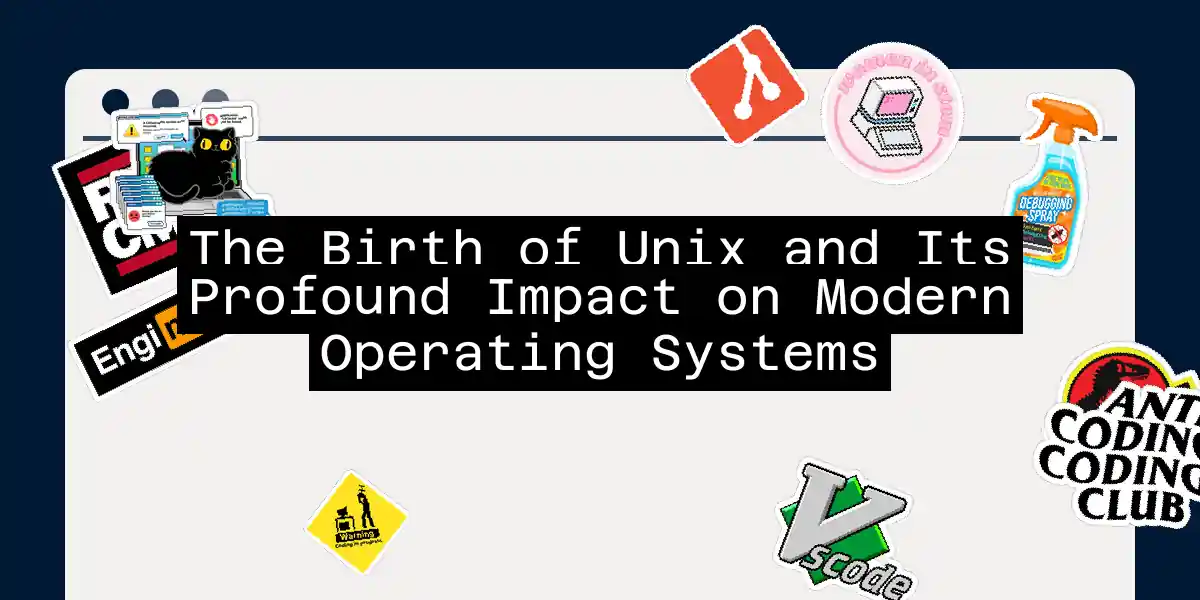The Genesis of Unix
In the realm of operating systems, few names carry as much weight as Unix. Born out of frustration with the complexities of the Multics project, Unix has evolved into a cornerstone of modern computing. Let’s delve into the fascinating history of Unix and explore how it has influenced the operating systems we use today.
From Multics to Unix
The story begins in the mid-1960s with the Multics (Multiplexed Information and Computing Service) project, a collaborative effort between MIT, General Electric, and Bell Labs. Multics aimed to create a time-sharing operating system, allowing multiple users to share the computing resources of a single machine. However, the project’s complexity and delays led to its eventual abandonment by Bell Labs in 1969.
Ken Thompson, Dennis Ritchie, and their colleagues at Bell Labs were not ready to give up on the idea of a multi-user, time-sharing system. They decided to create a new operating system, drawing from their experiences with Multics. This new project was initially called Unics, a playful jab at Multics, and later became known as Unix.
The Early Days of Unix
In 1969, Ken Thompson began experimenting with a PDP-7 computer at Bell Labs. He developed a custom interface to maximize the throughput of the disk drive, which eventually grew into a prototype operating system. Thompson realized that with just three more weeks of work, he could turn this interface into a full-fledged operating system by adding an editor, an assembler, and a kernel.
By November 1971, the first edition of Unix was released, followed by the second edition in July 1972. These early versions were remarkably robust, featuring many of the commands that are still in use today, such as cat, cd, chmod, and chown.
The Unix Philosophy
Unix was designed with a set of principles that would come to be known as the “Unix philosophy.” This philosophy emphasizes simplicity, modularity, and the use of small programs that can be combined to perform complex tasks. Each program should do one thing well, and the power of the system comes from the relationships among these programs rather than the programs themselves.
Key concepts of the Unix philosophy include:
- Hierarchical File System: Files are organized in a tree-like structure, with the root directory marked by a
/. - Everything is a File: Devices, hard disks, and even processes are treated as files within the file system.
- Pipes and Filters: Small programs can be strung together using pipes to perform complex tasks.
Growth and Influence
Unix quickly gained popularity in academic circles and beyond. Its portability, multi-tasking, and multi-user capabilities made it an attractive choice for various platforms. The first port of Unix to another platform was made in 1977 to the Interdata 7/32, marking the beginning of Unix’s journey to becoming a universal operating system.
The influence of Unix extends far beyond its own derivatives. It has shaped the development of numerous other operating systems, including Linux, macOS, and iOS. The Unix environment and client-server model were crucial in the development of the Internet and the shift towards network-centered computing.
Unix in Modern Operating Systems
Today, Unix’s legacy is evident in many modern operating systems:
- Linux: Uses GNU tools based on Unix documentation, making it a direct descendant of Unix. Linux supports modern architectures and includes a range of modern tools, but the core command-line experience remains similar to early Unix.
- macOS and iOS: These systems are built on top of the XNU kernel, which is descended from Mach, but they use many BSD userland tools, making them indirect descendants of Unix.
- BSD: FreeBSD and NetBSD are examples of Unix-based operating systems that continue to evolve and influence the broader Unix ecosystem.
Practical Examples and Code
To illustrate the enduring influence of Unix, let’s look at some common commands and how they are used in modern systems.
Example: Using ls Command
The ls command, which lists files and directories, has been a staple of Unix since its early days. Here’s an example of how you might use it in a modern Linux system:
ls -l /path/to/directory
This command lists the files in the specified directory in a detailed format, showing permissions, ownership, and timestamps.
Example: Using Pipes and Filters
One of the powerful features of Unix is the ability to combine small programs using pipes. Here’s an example of how you might use grep and sort to find and sort lines containing a specific keyword:
grep "keyword" /path/to/file | sort
This command searches for lines containing “keyword” in the specified file and then sorts the output.
Diagram: Unix History
To visualize the history and influence of Unix, here’s a simplified diagram using Mermaid syntax:
Conclusion
Unix’s impact on modern operating systems is undeniable. From its humble beginnings as a reaction to the complexities of Multics to its current status as a foundational element of many operating systems, Unix has left an indelible mark on computing. Its philosophy of simplicity, modularity, and the use of small programs has influenced generations of developers and continues to shape the software we use today.
As you navigate the command line of your favorite operating system, remember that you are using tools that have been refined over decades, thanks to the pioneering work of Ken Thompson, Dennis Ritchie, and their colleagues. The next time you use ls or grep, you’re not just executing a command; you’re participating in a legacy that has defined the course of computing history.
